The strategy on the corporate level typically considers a time frame of up to five years, or longer, depending upon the domain. It consists of vision, mission, values, and goals, corporate positioning, business model, and financial plan, product portfolio and its evolution, resource and competency evolution, technology trends and innovation strategy, market trends and competitive strategy, policies and governance. Software product managers will have to provide input whenever the corporate strategy is revisited and ensure that product strategies stay consistent with the corporate strategy.
Strategic Management is an activity within an organization with the content to define, plan, agree, implement and evaluate the organization’s strategy. It is part of the responsibility of executive management, who can delegate preparatory work to other functions. Software product managers are typically not responsible for any of these activities, but they either participate in them, e.g., portfolio management, provide inputs, or make use of their outputs, e.g., product analysis.

